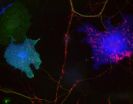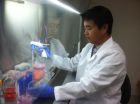(Press-News.org) GRAFTON, Mass. (January 28, 2013)—A popular dog treat could be adding more calories than pet owners realize, and possibly be contaminated by bacteria, according to a study published this month by researchers at the Cummings School of Veterinary Medicine at Tufts University and the University of Guelph.
The treat in question: the "bully" or "pizzle stick." The American and Canadian researchers analyzed the caloric density and bacterial contamination of these popular items, made from the uncooked, dried penis of a bull or steer. They also administered a survey to pet owners to assess their knowledge of these treats.
The study, published in the January 2013 issue of the Canadian Veterinary Journal, examined 26 bully sticks purchased from retailers in the United States and Canada and made by different manufacturers.
A random subset of the 26 bully sticks was tested for caloric content. These bully sticks tested contained between nine to 22 calories per inch, meaning the average six inch stick packed 88 calories--nine percent of the daily calorie requirements for a 50-pound dog, and 30 percent of the daily calorie requirements for a 10-pound dog.
"While calorie information isn't currently required on pet treats or most pet foods, these findings reinforce that veterinarians and pet owners need to be aware of pet treats like these bully sticks as a source of calories in a dog's diet," said Lisa M. Freeman, DVM, PhD, DACVN, professor of nutrition at TCSVM who is board-certified by the American College of Veterinary Nutrition.
Freeman was first author on the paper. Co-authors were J. Scott Weese, professor in the Department of Pathobiology at the University of Guelph, and Nicol Janecko, a research associate at the Canadian university.
"With obesity in pets on the rise, it is important for pet owners to factor in not only their dog's food, but also treats and table food," Freeman added.
All 26 treats were tested for bacterial contaminants. One (4 percent) of the sticks was contaminated with Clostridium difficile; one (four percent) was contaminated with methicillin-resistant Staphylococcus aureus (MRSA), a type of staph bacteria that is resistant to certain antibiotics; and seven (27 percent) were contaminated with Escherichia coli, including one tetracycline-resistant sample.
The number of treats sampled was small and not all of these bacterial strains have been shown to infect humans. However, the researchers advise all pet owners to wash their hands after touching such treats, as they would with any raw meat or raw meat diets. The very young, elderly, pregnant, immunocompromised and other high-risk individuals should avoid all contact with raw animal-product based treats and raw meat diets, note the scientists.
To learn more about veterinarian and pet owner perceptions of dog foods and treats, the research team developed a 20-question Web-based survey. The survey was posted online for public participation for 60 days and all responses were anonymous. It was completed by 852 adults from 44 states and six countries. Most respondents were female dog owners.
"We were surprised at the clear misconceptions pet owners and veterinarians have with pet foods and many of the popular raw animal-product based pet treats currently on the market," said Freeman. "For example, 71 percent of people feeding bully sticks to their pets stated they avoid by-products in pet foods, yet bully sticks are, for all intents and purposes, an animal by-product."
Another surprising finding was the large number of people who did not know what bully sticks actually were. A higher proportion of veterinarians (62 percent) were able to correctly identify the source of bully sticks as bull penis compared to general respondents (44 percent). Twenty-three percent of the respondents fed their dogs bully sticks.
Further research with a larger sample size is needed to determine whether the calorie content and contamination rate found in this study is representative of all bully sticks, or other types of pet treats, according to the authors.
INFORMATION:
For further details on pet nutrition and raw diets visit the TCSVM Foster Hospital for Small Animals FAQ site: http://www.tufts.edu/vet/nutrition/faq/general_pet_nutrition.html.
Freeman LM, Janecko N, Weese JS. Nutritional and microbial analysis of bully sticks and survey of opinions about pet treats. Canadian Veterinary Journal. 2013; 54: 50-54.
About the Cummings School of Veterinary Medicine at Tufts University
Founded in 1978 in North Grafton, Mass., Cummings School of Veterinary Medicine at Tufts University is internationally esteemed for academic programs that impact society and the practice of veterinary medicine; three hospitals and two clinics that combined log more than 80,000 animal cases each year; and groundbreaking research that benefits animal, public, and environmental health.
Misconceptions about a popular pet treat
Tasty bully sticks can add calories and carry bacteria
2013-01-28
ELSE PRESS RELEASES FROM THIS DATE:
Protein family linked to autism suppresses the development of inhibitory synapses
2013-01-28
Synapse development is promoted by a variety of cell adhesion molecules that connect neurons and organize synaptic proteins. Many of these adhesion molecules are linked to neurodevelopmental disorders; mutations in neuroligin and neurexin proteins, for example, are associated with autism and schizophrenia. According to a study in The Journal of Cell Biology, another family of proteins linked to these disorders regulates the function of neuroligins and neurexins in order to suppress the development of inhibitory synapses.
Like neurexins and neuroligins, the neuronal proteins ...
DNA-repairing protein may be key to preventing recurrence of some cancers
2013-01-28
Just as the body can become resistant to antibiotics, certain methods of killing cancer tumors can end up creating resistant tumor cells. But a University of Central Florida professor has found a protein present in several types of cancer, including breast and ovarian cancer, which could be helpful in preventing tumors from coming back.
The protein, KLF8, appears to protect tumor cells from drugs aimed at killing them and even aid the tumor cells' ability to regenerate.
"All cells have a DNA-repair mechanism," explained Jihe Zhao, a medical doctor and researcher who ...
Global research team decodes genome sequence of 90 chickpea lines
2013-01-28
Hyderabad, India, and Shenzhen, China (28 January 2013) – In a scientific breakthrough that promises improved grain yields and quality, greater drought tolerance and disease resistance, and enhanced genetic diversity, a global research team has completed high-quality sequencing of not one but ninety genomes of chickpea.
Nature Biotechnology, the highest ranked journal in the area of biotechnology, featured the reference genome of the CDC Frontier chickpea variety and genome sequence of 90 cultivated and wild genotypes from 10 different countries, as an online publication ...
Radial access should be first choice for PCI says ESC
2013-01-28
Sophia Antipolis, 28 January 2013: The radial approach for percutaneous coronary interventions (PCI) was developed 20 years ago and is used for more than 50% of procedures in France, Scandinavian countries, the UK, Spain and Italy. Despite the advantages of radial access some countries in Europe such as Germany use radial access for fewer than 10% of PCI.
Evidence has accumulated in the literature showing the benefits of radial over femoral access for PCI including reduced bleeding and improved survival. In addition, the development of smaller and thinner devices has ...
New technique sheds light on RNA
2013-01-28
ANN ARBOR, Mich. — When researchers sequence the RNA of cancer cells, they can compare it to normal cells and see where there is more RNA. That can help lead them to the gene or protein that might be triggering the cancer.
But other than spotting a few known instigators, what does it mean? Is there more RNA because it's synthesizing too quickly or because it's not degrading fast enough? What part of the biological equilibrium is off?
After more than a decade of work, researchers at the University of Michigan Comprehensive Cancer Center have developed a technique to ...
Study finds energy use in cities has global climate effects
2013-01-28
TALLAHASSEE, Fla. ⎯ The heat generated by everyday energy consumption in metropolitan areas is significant enough to influence the character of major atmospheric circulation systems, including the jet stream during winter months, and cause continental-scale surface warming in high latitudes, according to a trio of climate researchers that includes Ming Cai, a professor in Florida State University's Department of Meteorology.
Led by Guang Zhang, a research meteorologist at Scripps Institution of Oceanography at the University of California, San Diego, the scientists ...
University of Tennessee researcher finds 'first time' could predict sexual satisfaction
2013-01-28
Research conducted by Matthew Shaffer, a doctoral psychology student at UT and C. Veronica Smith, an assistant psychology professor at the University of Mississippi, reveals that the first sexual experience can set the tone for the rest of one's sexual life.
The study is published in the Journal of Sex and Marital Therapy and is the first to look at whether the circumstances of losing one's virginity have lasting consequences.
"The loss of virginity is often viewed as an important milestone in human development, signifying a transition to adulthood," said Shaffer. ...
Majority of Americans support dozens of policies to strengthen US gun laws
2013-01-28
The majority of Americans support a broad array of policies to reduce gun violence, according to a new national public opinion survey conducted by researchers at the Johns Hopkins Bloomberg School of Public Health. These policies include: requiring universal background checks for all gun sales (supported by 89 percent); banning the sale of military-style semiautomatic assault weapons (69 percent); banning the sale of large-capacity ammunition magazines (68 percent); and prohibiting high-risk individuals from having guns, including those convicted of a serious crime as a ...
Phone and mailed interventions significantly increase colorectal cancer screening rates
2013-01-28
PHILADELPHIA—A mailing or phone call to help patients get screened for colorectal cancer significantly increases their chances of actually getting tested, according to a study published in the January issue of Cancer Epidemiology, Biomarkers and Prevention by researchers at the Kimmel Cancer Center at Jefferson.
The research team, led by Ronald E. Myers, Ph.D., Professor and Director of Division of Population Science, Department of Medical Oncology at Thomas Jefferson University, performed a randomized, controlled trial of 945 people aged 50-79 to test the impact of a ...
Stanford researchers break million-core supercomputer barrier
2013-01-28
Stanford Engineering's Center for Turbulence Research (CTR) has set a new record in computational science by successfully using a supercomputer with more than one million computing cores to solve a complex fluid dynamics problem—the prediction of noise generated by a supersonic jet engine.
Joseph Nichols, a research associate in the center, worked on the newly installed Sequoia IBM Bluegene/Q system at Lawrence Livermore National Laboratories (LLNL) funded by the Advanced Simulation and Computing (ASC) Program of the National Nuclear Security Administration (NNSA). Sequoia ...
LAST 30 PRESS RELEASES:
A bacterial toxin can counteract colorectal cancer growth
Frozen hydrogen cyanide ‘cobwebs’ offer clues to origin of life
Physics of foam strangely resembles AI training
Bis-pseudoindoxyls: a new class of single benzene-based fluorophores for bioimaging applications
Blocking a cancer-related pathway helps reduce spine deformities due to genetic disorder, finds new study
New study explores therapeutic potential of CRISPRCas3 genome-editing system
Korea University researchers revive an abandoned depression drug target using structurally novel NK1 receptor inhibitors
Jeonbuk National University researchers highlight advancements in chemical looping fluidized bed reactors
Tyrannosaurus rex grew up slowly: New study reveals the “king of dinosaurs” kept growing until age 40
Commercial water dispenser machines may contain more contamination than tap water
Death and doctors: New WSU study looks at medical student education on end-of-life care
The best hydrogen for heavy-duty transport is locally produced and green
Pregnancy-related high blood pressure varied among Asian, Pacific Islander subgroups
Measuring movement creates new way to map indoor air pollution
Europe’s crop droughts to get worse even as rain increases
New study identifies signature in blood to better predict type 2 diabetes risk
Research spotlight: developing “smart” nanoparticles to deliver targeted gene therapy in osteoarthritis
A CRISPR fingerprint of pathogenic C. auris fungi
Time warp: How marketers express time can affect what consumers buy
CBD treatment reverses key effects of fetal alcohol spectrum disorder in a mouse model
Blood sugar spikes linked to higher risk of Alzheimer's disease
Staying single for longer affects young people’s well-being
New method allows scientists to 3D-print structures within cells
Screening tool helps identify brain-related comorbidities in individuals with Duchenne muscular dystrophy
How do the active ingredients of monkfruit affect health?
News language and social networks: how do they affect the spread of immigration attitudes?
Researchers discover trigger of tendon disease
Your pet's flea treatment could be destroying the planet
Diabetes risk not associated with timing or type of menopause
Bulk inorganic crystals grown from water emit “handed” light
[Press-News.org] Misconceptions about a popular pet treatTasty bully sticks can add calories and carry bacteria




